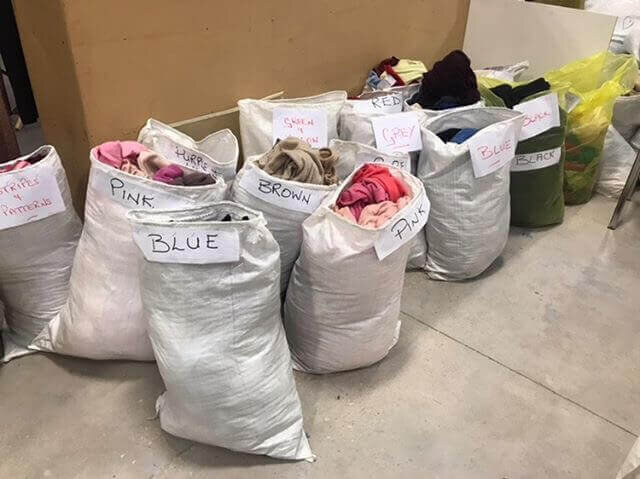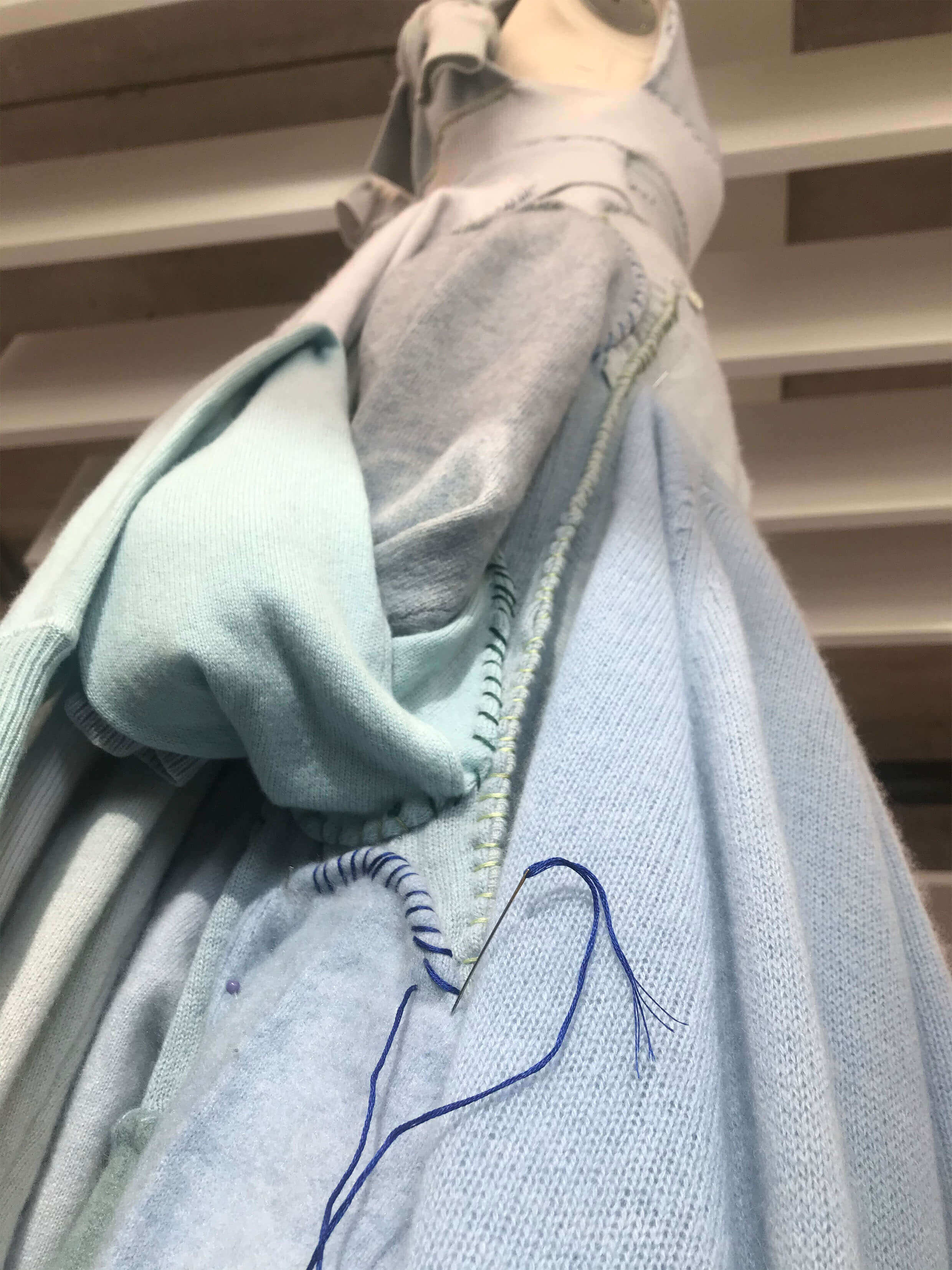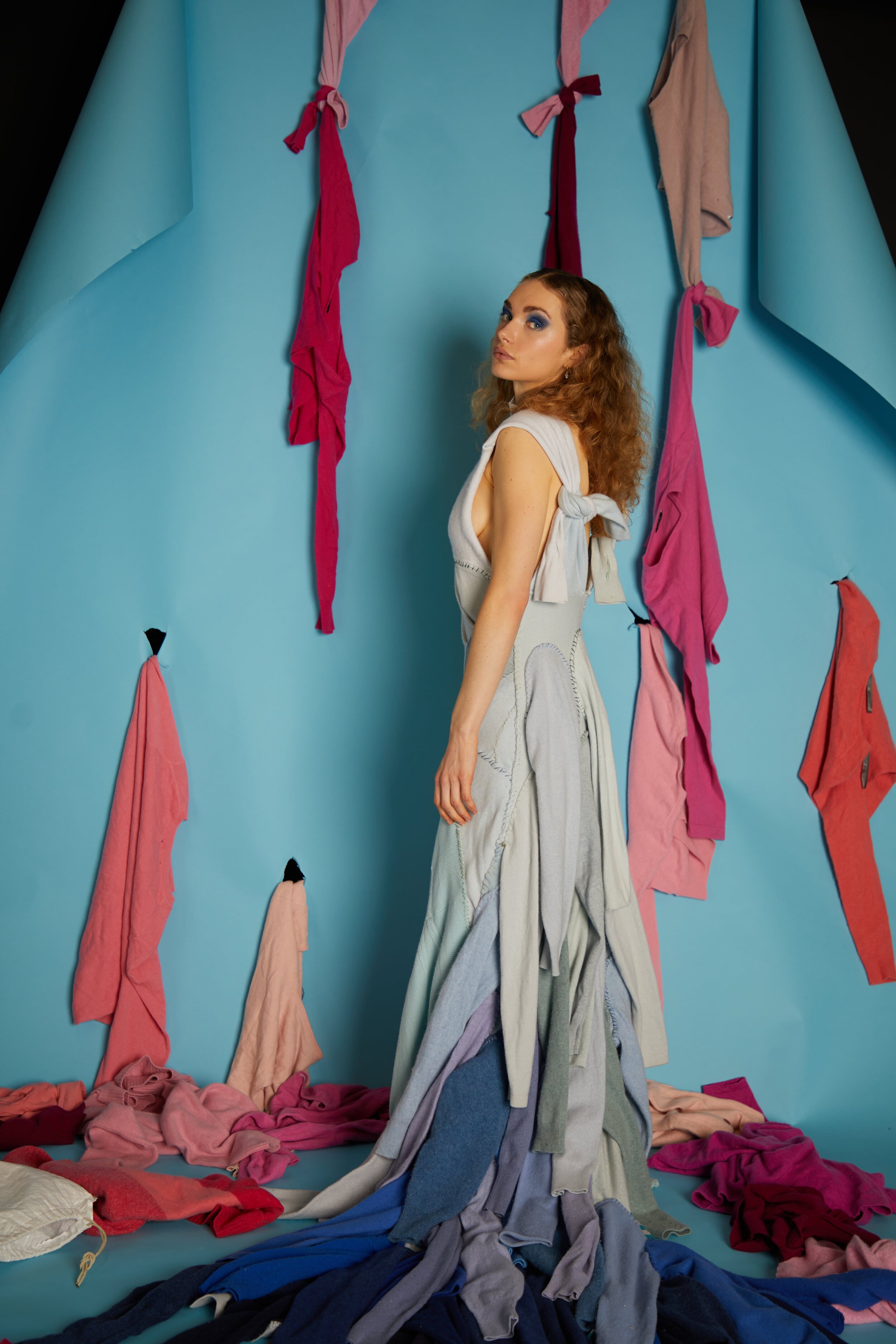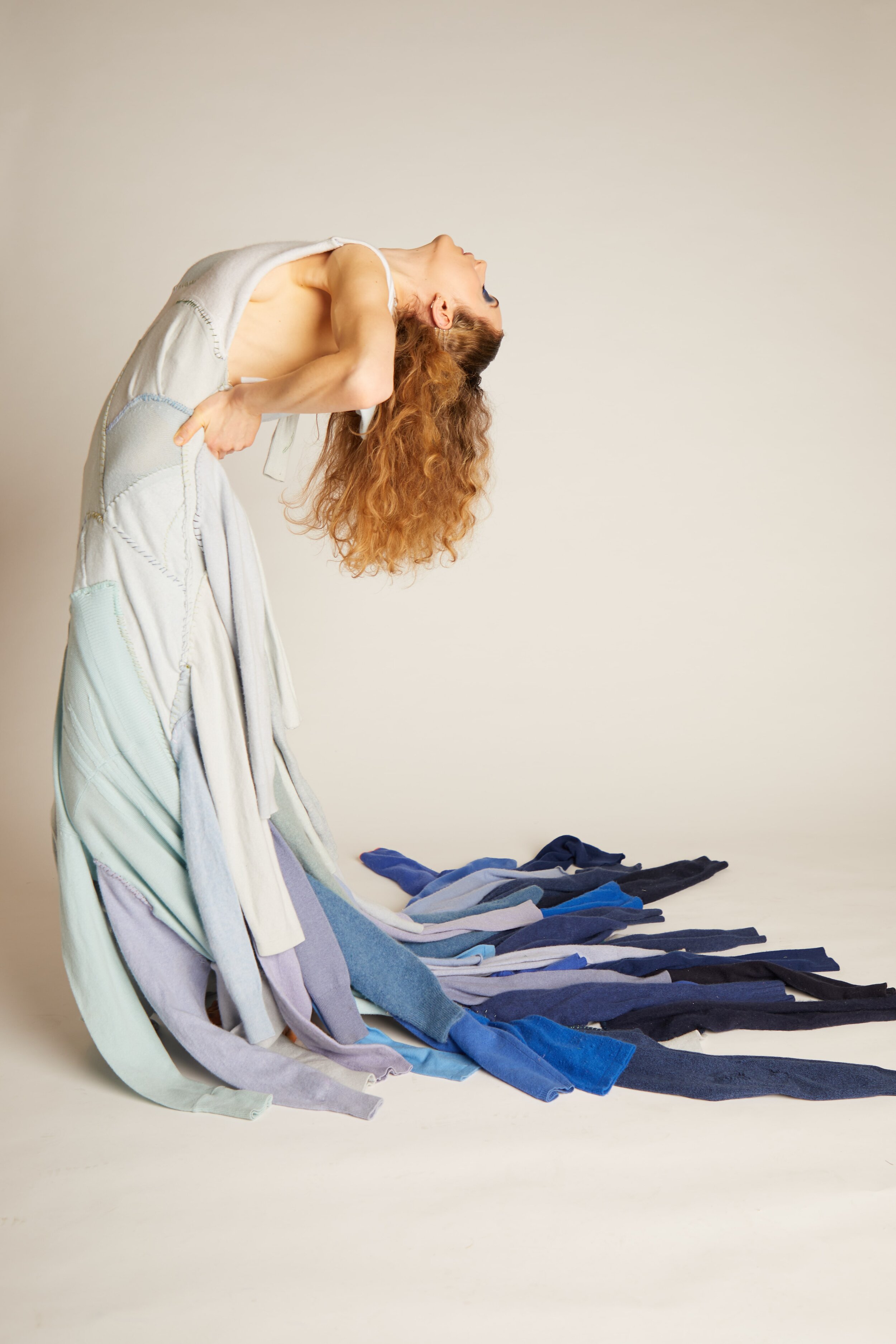Gracie D’Silva
Meet GFF Talent Gracie D’Silva, a fashion design graduate from Leeds Arts University. After visiting the Oxfam Wastesaver facility earlier this year, Gracie was inspired to create an up-cycled collection made of recycled cashmere. Her final year project has been an exploration of reusing fabrics and creating something exciting and innovative without creating more waste. Learn more about Gracie’s collection below and discover what she’s looking forward to after graduation.
What is the most valuable thing you have learnt at university?
Learning to develop my own style and that the outcome of my work doesn't have to look a certain way is the most valuable thing I have learnt during my time at university. I was never a confident drawer, I always found it difficult to illustrate my designs. I think this is because we are all brought up with the perspective that there is a right and wrong way to do things and this theory can continue into our artistic choices. When I stopped pressuring myself to meet these unrealistic expectations, I was able to develop my own style and design more freely.
Most recently I have enjoyed creating mixed media illustrations using old magazines and oil pastels in order to create more textured and lively illustrations. Illustrating was not the only part of my style I learnt to develop; I also realised my specialisation while in my final year at university. Up-cycling and sustainability had always been areas I was conscious about from a young age; however, I never fully pursued them. When it came to creating my graduate collection, I knew I didn’t want to buy new materials when there were already so many unused fabrics out there I could use. This is when I started up-cycling for Oxfam Online as an intern and learnt how simple it was to transform old clothing into something completely new.
I particularly liked reusing original features from clothing such as fastenings/ darts and using these as interesting design features. Inspired by the Redress Design award, I was conscious about up-cycling large quantities of unwanted clothing/ materials and this is something Oxfam was able to offer me on a large scale. The designs I started to create from second-hand clothing were really unique compared to my previous designs, I saw this as a more expressive way to design on the stand rather than sketching out my ideas.
What was the starting point of inspiration for your final project?
The starting point for my collection began when I first started interning at Oxfam Online at their Wastesaver facility. I was shocked to see just how many bundles of clothing were having to be sent to developing countries, due to the amount of second-hand clothing that cannot be sold in the UK, because of the scale of it. Some of these clothes were perfectly fine and some even brand new but couldn’t be sold due to how much of it there was. I saw how much stock Oxfam has to reject because it is damaged or unfit to sell. This included a large quantity of cashmere, this couldn’t be sold because they were washed incorrectly or damaged.
I wanted to upcycle this cashmere and transform it back into a luxury product. When selecting my colour palette, I focused on the colour cashmere which had the largest quantity, this was pink and blue. Inspired by Ahluwalia and Maddie Williams, I wanted to create my own up-cycled collection reusing unwanted clothing and transforming it into something completely new. I particularly like their use of colour and mix of prints; this was something I wanted to demonstrate within my collection. In addition, I had just become a student ambassador for Fashion Revolution and saw the importance of asking brands ‘who made my clothes’ and learnt about the lack of transparency in the fashion industry.
I wanted to combine both the companies/ organisations I was working for and make these the theme of my collection. I sourced my fabric from Oxfam and so I was able to reflect the grand scale of textile waste from this and Fashion Revolution provided a starting point for the lack of transparency within the fashion industry. When creating the line up of my collection, I made sure to include Fashion Revolution’s ‘who made my clothes’ signs.
What form will your final project take?
My collection will take the form of 5 up-cycled garments. The colour placement for each outfit was smartly planned, in order to distribute the two colours I was using, in the most effective way for each outfit. The outfits will all be made from 100% cashmere; this will be hand-stitched together in patches. This will be achieved through draping the cashmere jumpers on the stand and then cutting parts away to create the silhouette for each outfit. My press outfit will be highlighting the mass amount of textile waste created from the fashion industry.
This is demonstrated by the dramatic build-up of sleeves creating a train from the dress. My press outfit follows a balayage colour balance in order to show the grand scale of damaged jumpers I was able to source through having access to so many different shades of blue. The jumpers I used for my collection were all damaged, however I managed to repair all the jumpers I used, with little to no evidence of this within my designs. Demonstrating that once something is damaged, it doesn’t necessarily need to be chucked or given away, it just needs to be repaired.
Taking reference from the ethos’s of COS and Other Stories, I wanted the rest of my collection to be timeless, simple pieces that were valued and could be passed down to generations. Contrasting from fast fashion, I aimed to create pieces that people would want to hold onto and continue to wear, rather than wear a few times and want to replace with something new. My next 4 outfits focus on following the qualities of cashmere focusing on comfort from the soft handle of the fabric and simple silhouettes achieved through how flattening cashmere is to drape. These will be a mix of matching outfit sets including trousers, skirts and jumper tops.
What materials have you used and how did you source them?
My collection is mainly made from 100% cashmere in the form of jumpers, sourced from Oxfam Online. These jumpers were from Oxfam’s rejected stock but were restored as I used them, in order to make the cashmere look like it was never damaged in the first place. I decided to use cashmere for my collection because previously it was considered a natural fibre with its ability to decompose and is obtained from goats. However, in recent years it has become easier to gain access to due to fast fashion, therefore cashmere is now produced on a much larger scale. With this increased growth in the cashmere market creates a new strain on resources such as the number of goats now needed to produce cashmere on this new scale as well as the destruction of natural habitats as a result of the growing cashmere industry.
It is now considered an unsustainable fabric with how accessible it has become, evidenced by just how much rejected cashmere Oxfam was able to offer me access to, a large proportion of this cashmere originally from fast fashion brands. Amongst cashmere, I also reused an old calico toile within my press outfit in order to give the bodice of the dress support from the weight of the sleeve trail. All the fastenings within my collection were utilized from the original cashmere jumpers I bought; including buttons and hook and eyes. My collection was all hand-stitched together using embroidery threads I already owned from when I used to do hand embroidery. If I needed any more embroidery threads, I was able to buy these from the charity shop haberdasheries. I decided to use a range of different coloured embroidery threads when hand sewing my collection in order to provide a mend and repair aesthetic in the form of a whip stitch construction.
How has it evolved from your initial ideas and what have you learnt along the way?
Initially, each outfit within my collection was going to be made from a different piece of clothing. For example, one outfit was going to be made from men’s shirts, the next from blazers, etc. However, I found that I was not able to source as much of a range of different pieces of clothing as I was of the cashmere, in order to make a consistent collection. From upcycling, I have learnt how to design well so that I design for longevity and purpose. Such as using certain techniques to make my garments circularly designed so the wearer can repair them, themselves when they become damaged or completely transform the fabric from the garment into a new outfit.
How to cleverly reuse the original features of a garment as a completely new function on a different garment. I have learnt the passion that comes with upcycling what was once an unwanted piece of clothing back into desired, luxury garment. Such as the cashmere I sourced for my collection, this was sat in bags stained or with holes in the jumpers and I was able to transform this unwanted/ damaged item into a desirable collection. I have learnt how creative I can be through draping on the stand, this was never an approach I used to take when designing. Through draping, I have also learnt how much textile waste is produced through toiling in calico. I tried to avoid toiling when designing my own collection, in order to not use up my collection resources. Through hand stitching my collection together I am easily able to unpick and reposition a patch of cashmere if I don’t like the way it looks, resulting in not needing to toile my collection ideas. Finally, I have learnt how to be resourceful with my materials, how to use all aspects of my fabrics in order to be less wasteful.
What are the messages and themes behind your project that you want people to take away? Do explore any topics like diversity, sustainability or politics in your work?
Sustainability and the ethics of workers within the fashion industry are the key themes within my collection. My collection highlights the mass amount of textile waste sent to landfill or cast off to developing countries weekly. I up-cycled second hand damaged clothing in order to demonstrate just how much of a key role overconsumption and overproduction play within making the industry so polluting. The range of shades of blue and pink across my collection demonstrate the large range of damaged cashmere I had access to and all this cashmere was donated to charity shops across the UK even though it was damaged.
This shows how wasteful modern consumers have become, that we have become a throwaway society instead of taking lessons from older generations who still adopt a mend and repair strategy. My collection aims to show just how much our shopping habits and fast fashion have changed the fashion industry’s impact on the environment. In addition, the lack of transparency within the fashion industry is one of the key themes of my collection. The cashmere used for my collection was made and shipped all across the world, but I couldn't name or say any of the people who made one of these jumpers were treated fairly because I have no idea who they are.
My whole collection was handmade and the fabric sourced was second hand, the money used to buy the cashmere jumpers will go onto support those in poverty. I wanted to create a sustainable and ethical collection that will not go on to harm the environment or support unethical treatment/ working conditions. I wanted to create a collection that is sustainable but doesn’t let this compromise its desirability, especially when it raises awareness of textile waste and the lack of transparency of brands in the fashion industry.
What’s an aspect of the fashion industry that you’re passionate about fixing or having a positive impact on?
The themes of my collection are also aspects of the fashion industry that I am passionate about fixing. A lot of people I speak to think sustainability within fashion is a trend when really it is the realisation of how much damage the fashion industry does to the environment and continues to do while ignoring the problem. The fashion industry is now the second most polluting industry in the world, after oil. Many comedians and presenters such as Stacey Dooley and Hasan Minhaj have started to discuss this in a hope to shine a light on an industry which is overlooked and not well informed on.
When Stacey Dooley asked shoppers to rank parts of the industry from most sustainable to least sustainable, almost everyone ranked fashion last as least sustainable. I want more people to come to a realisation of how much damage they are doing when they shop excessively and in particular buy into fast fashion brands. The consumer, the retailer and the designer are all responsible for how fashion they design, sell or buy effects the environment. I think the consumer needs to start spending with their wallets to show how they want the industry to look. I think the mass amount of textile waste will only reduce if consumers stop buying into fast fashion so these brands start to make a change to appeal to the consumer’s new mindset. In addition, since May of 2019, I have stopped buying new clothing in particularly those from fast fashion brands where it is unknown if these clothes are ethically made. Since being a student ambassador at Fashion Revolution, I have realised just how much of the garment manufacturing industry is in the dark about its workers who make clothes for UK brands and how these workers are treated.
What is your plan once you finish your BA?
After I have finished my BA and the current situation has resolved, I planned to undertake paid internships in London, focusing on sustainability. Once I have obtained these new skills and approaches, myself and some other friends planned to set up our own studio so we could focus on selling our designs and share some of the costs of equipment and studio space. Now that we are all at home and self-isolating, I think we have learnt how much we loved being in the studio together, supporting each other, motivating each other through the late nights and watching Disney films in the studio.
I think that is something we were looking to recreate when setting up our own studio. In addition, I am looking forward to going travelling again and meeting up with friends from different countries. Once I have submitted my final year work, I am looking forward to being able to do all the projects I thought up while making my collection and actually being able to sell my own designs. The projects I had planned included upcycling second-hand clothes in order to produce some of my previous designs on a larger scale so I could sell them and start to develop my brand into a business.
Over the last 3 years of university, I have obtained a range of deadstock fabric from university and suppliers and I hoped to be finally able to use these. I hoped to carry on my internship at Oxfam so I can continue to creatively support the great work they are doing through upcycling their unwanted stock and repairing vintage clothing. Finally, I am really looking forward to finishing my graduate collection and being able to collaborate again with other design students so I can photograph it as I previously had planned.













